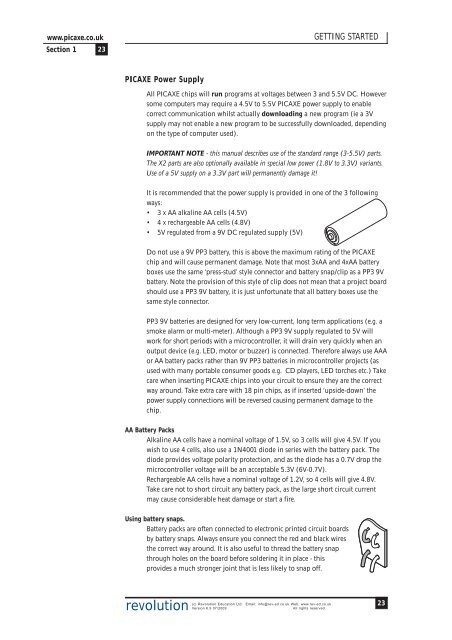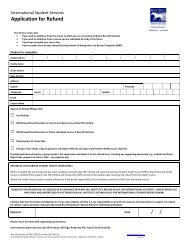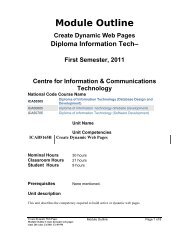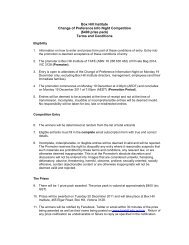PICAXE Manual Section 1 - TechnoPujades - Free
PICAXE Manual Section 1 - TechnoPujades - Free
PICAXE Manual Section 1 - TechnoPujades - Free
- No tags were found...
You also want an ePaper? Increase the reach of your titles
YUMPU automatically turns print PDFs into web optimized ePapers that Google loves.
www.picaxe.co.uk<strong>Section</strong> 1 23GETTING STARTED<strong>PICAXE</strong> Power SupplyAll <strong>PICAXE</strong> chips will run programs at voltages between 3 and 5.5V DC. Howeversome computers may require a 4.5V to 5.5V <strong>PICAXE</strong> power supply to enablecorrect communication whilst actually downloading a new program (ie a 3Vsupply may not enable a new program to be successfully downloaded, dependingon the type of computer used).IMPORTANT NOTE - this manual describes use of the standard range (3-5.5V) parts.The X2 parts are also optionally available in special low power (1.8V to 3.3V) variants.Use of a 5V supply on a 3.3V part will permanently damage it!It is recommended that the power supply is provided in one of the 3 followingways:• 3 x AA alkaline AA cells (4.5V)• 4 x rechargeable AA cells (4.8V)• 5V regulated from a 9V DC regulated supply (5V)Do not use a 9V PP3 battery, this is above the maximum rating of the <strong>PICAXE</strong>chip and will cause permanent damage. Note that most 3xAA and 4xAA batteryboxes use the same ‘press-stud’ style connector and battery snap/clip as a PP3 9Vbattery. Note the provision of this style of clip does not mean that a project boardshould use a PP3 9V battery, it is just unfortunate that all battery boxes use thesame style connector.PP3 9V batteries are designed for very low-current, long term applications (e.g. asmoke alarm or multi-meter). Although a PP3 9V supply regulated to 5V willwork for short periods with a microcontroller, it will drain very quickly when anoutput device (e.g. LED, motor or buzzer) is connected. Therefore always use AAAor AA battery packs rather than 9V PP3 batteries in microcontroller projects (asused with many portable consumer goods e.g. CD players, LED torches etc.) Takecare when inserting <strong>PICAXE</strong> chips into your circuit to ensure they are the correctway around. Take extra care with 18 pin chips, as if inserted ‘upside-down’ thepower supply connections will be reversed causing permanent damage to thechip.AA Battery PacksAlkaline AA cells have a nominal voltage of 1.5V, so 3 cells will give 4.5V. If youwish to use 4 cells, also use a 1N4001 diode in series with the battery pack. Thediode provides voltage polarity protection, and as the diode has a 0.7V drop themicrocontroller voltage will be an acceptable 5.3V (6V-0.7V).Rechargeable AA cells have a nominal voltage of 1.2V, so 4 cells will give 4.8V.Take care not to short circuit any battery pack, as the large short circuit currentmay cause considerable heat damage or start a fire.Using battery snaps.Battery packs are often connected to electronic printed circuit boardsby battery snaps. Always ensure you connect the red and black wiresthe correct way around. It is also useful to thread the battery snapthrough holes on the board before soldering it in place - thisprovides a much stronger joint that is less likely to snap off.revolution(c) Revolution Education Ltd. Email: info@rev-ed.co.uk Web: www.rev-ed.co.ukVersion 6.9 07/2009All rights reserved.23
















